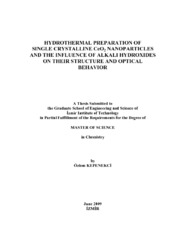Please use this identifier to cite or link to this item:
https://hdl.handle.net/11147/4070Full metadata record
| DC Field | Value | Language |
|---|---|---|
| dc.contributor.advisor | Eanes, Mehtap | - |
| dc.contributor.advisor | Eanes, Mehtap | - |
| dc.contributor.author | Kepenekci, Özlem | - |
| dc.date.accessioned | 2014-07-22T13:53:07Z | - |
| dc.date.available | 2014-07-22T13:53:07Z | - |
| dc.date.issued | 2009 | - |
| dc.identifier.uri | http://hdl.handle.net/11147/4070 | - |
| dc.description | Thesis (Master)--İzmir Institute of Technology, Chemistry, İzmir, 2009 | en_US |
| dc.description | Includes bibliographical references (leaves: 60-64) | en_US |
| dc.description | Text in English; Abstract: Turkish and English | en_US |
| dc.description | xii, 64 leaves | en_US |
| dc.description.abstract | Single crystalline cerium oxide nanoparticles were synthesized via hydrothermal method by mixing aqueous solution of cerium nitrate [Ce(NO3)3.6H2O] with an alkali base. Several characterization methods were used to identify morphology and crystalline nature such as X-ray Diffraction, Scanning and Transmission Electron Microscopes. This study is divided into three parts. In the first part, some controlling parameters like, that were affecting size and shape of CeO2 nanoparticles, were studied. It was found that size of CeO2 nanoparticles increased when increasing both reaction time and temperature. Alkali base concentration promoted the particle growth. Also, particle morphology was more uniform rather than aggregated in presence of higher concentrated alkali base. When the alkali base type was changed, the use of NaOH produced larger cubic nanocrystals of CeO2 than KOH and LiOH.Second part is related to determine the optical properties of CeO2 nanoparticles. Based on the UV-Vis and Fluorescence Spectroscopy results, size, bandgap and defect level of CeO2 nanoparticles can be easily determined. Nanoparticles in presence of NaOH alkali base were found to produce less defective CeO2 nanoparticles as compared to KOH and LiOH. The last part of this work is to evaluate the shape effect on morphology, size and optical properties of CeO2 nanoparticles. Rod crystals of CeO2 were produced when the hydrothermal synthesis temperature was low (120°C) or when the reaction time was short (1 hour). When the synthesis temperature was higher than 160°C well defined cubic crystals of CeO2 started to form. | en_US |
| dc.language.iso | en | en_US |
| dc.publisher | Izmir Institute of Technology | en_US |
| dc.rights | info:eu-repo/semantics/openAccess | en_US |
| dc.subject.lcc | TP248.25.N35 .K38 2009 | en |
| dc.subject.lcsh | Nanotechnology | en |
| dc.subject.lcsh | Nonoparticles | en |
| dc.subject.lcsh | Hydrothermal alteration | en |
| dc.subject.lcsh | Hydroxides | en |
| dc.title | Hydrothermal Preparation of Single Crystalline Ceo2 Nanoparticles and the Influence of Alkali Hydroxides on Their Structure and Optical Behavior | en_US |
| dc.type | Master Thesis | en_US |
| dc.institutionauthor | Kepenekci, Özlem | - |
| dc.department | Thesis (Master)--İzmir Institute of Technology, Chemistry | en_US |
| dc.relation.publicationcategory | Tez | en_US |
| dc.identifier.wosquality | N/A | - |
| dc.identifier.scopusquality | N/A | - |
| item.grantfulltext | open | - |
| item.openairecristype | http://purl.org/coar/resource_type/c_18cf | - |
| item.fulltext | With Fulltext | - |
| item.cerifentitytype | Publications | - |
| item.languageiso639-1 | en | - |
| item.openairetype | Master Thesis | - |
| Appears in Collections: | Master Degree / Yüksek Lisans Tezleri | |
Files in This Item:
| File | Description | Size | Format | |
|---|---|---|---|---|
| T000820.pdf | MasterThesis | 5.02 MB | Adobe PDF |  View/Open |
CORE Recommender
Page view(s)
286
checked on Jul 7, 2025
Download(s)
344
checked on Jul 7, 2025
Google ScholarTM
Check
Items in GCRIS Repository are protected by copyright, with all rights reserved, unless otherwise indicated.